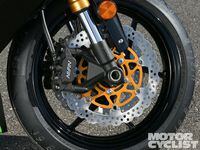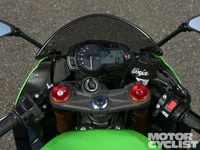They say: "More performance. More fun!"
We say: "For every kind of rider."
When developing the 2013 ZX-6R, Kawasaki let statistics be its guide. Owner surveys say that 67 percent of ZX-6R buyers are relatively new to the sport and have held a license for 5 years or less. At the same time, a third of ZX-6R owners say they take their Ninja to the racetrack. For neophytes, the bike needs to be approachable and easy to ride. For track riders, the bike needs to be sharp and performance-oriented. Those requirements seem mutually exclusive, but one factor handily addresses both criteria: Displacement.
On the street or at the track, a broader spread of power is always better. So just like it did a decade ago, Kawasaki pushed the ZX-6R’s displacement from the class norm of 599cc to 636cc in an effort to increase low-end and midrange power. More grunt wasn’t the only strategy for improvement, however. Kawasaki took the opportunity to update the Ninja’s suspension, brakes, and styling, and added traction control, switchable power modes, and optional anti-lock brakes.
The Ninja’s displacement bump comes from a stroke increase of 2.6mm. In addition to an additional 37cc, the ZX-6R’s supporting systems were tuned to compliment the increase in lung capacity. The Ninja’s airbox is bigger, and new injectors can flow more fuel. The bike also has new cams, as well as reshaped pistons to accommodate the increased valve lift and reduce compression slightly, from 13.1:1 to 12.9:1. On the exhaust side, all four header pipes are bridged and there’s a slim-looking triangular muffler. Aside from the crankshaft, most everything between the engine cases is the same. First gear is shorter and the rest of the cogs are stronger to cope with the Ninja’s increased torque. The clutch was also replaced with an “assist and slipper” unit as on the Ninja 300. But, otherwise, the ZX-6R’s powerplant is familiar.
Kawasaki’s American arm wouldn’t reveal power figures, but the reps confirmed that the bike is in the same state of tune as the European model. Those claims are for 129.0 horsepower at 13,500 rpm and 52.4 lb.-ft. torque at 11,500 rpm. That’s well up on the 2012 bike’s 124.4 bhp and 49.2 lb.-ft. claimed output, but peak power isn’t the 636’s focus. A dyno chart comparing the two showed the new Ninja’s curves soaring above the previous model’s, especially in the midrange.
The best place to experience horsepower is on a racetrack, so Kawasaki invited journalists to Thunderhill Raceway in Willows, CA, to try out the new Ninja. The previous bike’s ergonomics remain, which is good because that machine offered a great rider interface on the track and a reasonable riding position on the street. New body panels cover the upper frame spars, creating a broad concave clamping surface for your legs. The clip-ons are low and wide, and the rearsets are fairly high, but the bike’s ergos aren’t extreme.
Most machines necessitate an adjustment period, but the ZX-6R is an exception. It’s one of those rare bikes that feels like you’ve been riding it for years even though it’s your first time twisting the throttle. The previous ZX-6R had strong midrange power, but the new 636 is just so much stronger. It pulls from 6000 rpm and rips from 8000 rpm on up until the shift light flickers on at 14,000 rpm. With the 636 you can shift less and go faster. In fact, our fastest lap times were turned while carrying a gear rather than down-shifting.
Just riding through the pits you notice that the Ninja’s steering feels essentially effortless, and that sensation is even more apparent at speed. It steers quicker due in part to steeper geometry but also from elimination of the steering damper. Kawasaki engineers claim that street riders didn’t like the way it made the steering feel heavy at slow speeds, so they ditched the previous bike’s adjustable Öhlins unit. They even went so far as to install new, slicker steering head seals to reduce drag. But surely track riders need a damper? The bike did shake its head while driving toward Turn 2 and when cresting the hill at Turn 9, but it wasn’t unmanageable or even unnerving.
The frame and swingarm are the same parts used on the previous model, but Showa’s new Separate Function Fork Big Piston (SFF-BP) replaces the previous BPF, and has softer springs and damping rates. The shock has a longer, softer spring and more progressive linkage. More rear ride height and less front ride height cant the chassis forward, steepening the steering angle slightly. The Showa fork’s softer springs and extra-large damping piston allow the front suspension to be plusher toward the top of the stroke without being too soft; it’s compliant enough to absorb bumps but stiff enough to prevent the chassis from pitching excessively. That makes life easier for newbs cruising bumpy city streets and track junkies trying to turn a faster lap.
Thunderhill’s Turn 3/Turn 4 transition demands response, and the Ninja’s ability to snap from hard right to hard left made that section easy to manage. The Ninja turns in instantly and will cooperate with any mid-corner corrections you may make. This is one of those special sportbikes that does everything you ask and quickly lets you know that you, the rider, will be the limiting factor in the equation.
For 2013, the Ninja gets the ZX-10R’s rear brake caliper and Nissin one-piece calipers up front, working with new pad compounds and bigger, 310mm rotors. KIBS ABS is also available, though the bikes we rode weren’t equipped. We expected the setup to have a stronger bite due to the larger discs and the calipers’ bigger pistons, but the initial engagement is softer, with a more progressive feel as you increase lever pressure. Kawasaki techs said they retuned to the brakes to offer more feel and control, and they do. Power during maximum deceleration while vertical tests your push-up strength, while excellent feel during trail braking allowed us to confidently continue shedding speed long after our knee puck kissed the pavement. The new clutch allows more slip than the previous pack, so the back end does not chatter after downshifting, and it rarely slides while charging into corners.
Like the ZX-10R, the ZX-6R is the first Japanese bike in its class to offer traction control. KTRC is a terrific safety net, but proved unnecessary thanks to the traction offered by Bridgestone’s latest R10 race tires, which were levered on for our track test. Even with aggressive throttle input, KTRC was hard to activate in Level 1, but in Level 2 it kicked in frequently, with a muffled exhaust note indicating the ignition cut used to reduce torque and tire slippage. Level 3 is reserved for extremely slippery conditions, and manages wheel spin via spark, fuel, and manipulation of the secondary throttle butterflies.
Some machines get irked if you try to turn in on the brakes, choose the wrong gear or adjust your line mid-corner, but the Ninja proved nearly impossible to upset or catch off-guard. The only unexpected thing the bike did was chatter through some of the track’s faster, bumpier corners. We worked with Kawasaki’s ace tuner Joey Lombardo to try to eliminate the issue, and while we weren’t successful on that front Joey did manage to make the bike steer sharper and finish corners better by adding more preload to the shock.
The following day’s ride in the hills above Lake Oroville showed that the new Ninja is still an accommodating street bike. The 636’s added power meant few shifts were necessary, and while the stock suspension settings we rode on slowed steering slightly, the bike still turned and tracked with perfect stability. A new fairing shape does a good job of channeling wind around the rider’s head and shoulders, and the Ninja’s new mirrors provide a pretty good rearward view. This bike is well-refined, with perfect fueling, broadband power, a composed chassis, and impressive electronics. Much of what Kawasaki did to the bike seems to have been to appease new riders that spend most of their time on the street, but the bike’s trackworthiness hasn’t been compromised, it’s been increased.
The 636 is substantially updated, with an appreciable increase in performance. It’s also more expensive, with $1400 added to last year’s $10,299 price tag. KIBS adds another $1000 to that number. Still, without ABS, the ZX-6R is priced to match other manufacturer’s offerings, yet offers much more performance and better features for the price. The 636 is back. Riders of all skill levels have cause to rejoice, and manufacturers of Kawasaki’s middleweight competition have every right to worry.
EVOLUTION
The 636's return is marked by a return to a 636cc engine, Showa's new SFF-BP, bigger brakes, and the addition of KTRC, KIBS, and variable engine modes.
RIVALS
Honda CBR600RR, Suzuki GSX-R600 and 750, Ducati 848, Triumph Daytona 675, Yamaha YZF-R6
VERDICT 4.5 out of 5 stars
_An incredible sportbike, no matter what kind of riding you do. _

















/cloudfront-us-east-1.images.arcpublishing.com/octane/G4MG6OUCJNBSHIS2MVVOTPX65E.jpg)
/cloudfront-us-east-1.images.arcpublishing.com/octane/IIGGWFOTOJGB7DB6DGBXCCMTDY.jpg)
/cloudfront-us-east-1.images.arcpublishing.com/octane/QSTCM6AVEZA5JJBUXNIQ3DSOF4.jpg)
/cloudfront-us-east-1.images.arcpublishing.com/octane/U4I7G625B5DMLF2DVIJDFZVV6M.jpg)
/cloudfront-us-east-1.images.arcpublishing.com/octane/B6XD6LS6IVCQPIU6HXDJSM3FHY.jpg)
/cloudfront-us-east-1.images.arcpublishing.com/octane/ICL63FEDDRDTTMINYICCEYGMDA.jpg)
/cloudfront-us-east-1.images.arcpublishing.com/octane/FCGZHQXRBZFLBAPC5SDIQLVF4I.jpg)
/cloudfront-us-east-1.images.arcpublishing.com/octane/WNOB6LDOIFFHJKPSVIWDYUGOPM.jpg)

/cloudfront-us-east-1.images.arcpublishing.com/octane/X33NU3E525ECRHXLNUJN2FTRKI.jpg)
/cloudfront-us-east-1.images.arcpublishing.com/octane/6KKT5NNL2JAVBOXMZYS5ZO76YA.jpg)
/cloudfront-us-east-1.images.arcpublishing.com/octane/J5RKG5O455GMPGQRF2OG6LRT7A.jpg)
/cloudfront-us-east-1.images.arcpublishing.com/octane/GX2CIZKQVRH2TATDM26KFG2DAE.jpg)
/cloudfront-us-east-1.images.arcpublishing.com/octane/ZWIDYSAKQZHD5BHREMQILXJCGM.jpg)
/cloudfront-us-east-1.images.arcpublishing.com/octane/CYUHJZCTSJCH3MRAQEIKXK7SCQ.jpg)
/cloudfront-us-east-1.images.arcpublishing.com/octane/LKOFINY56FCXJCANJ5M7ZDQUBY.jpg)
/cloudfront-us-east-1.images.arcpublishing.com/octane/4NBPDACMWJH63JQYJVK3QRBDZI.jpg)
/cloudfront-us-east-1.images.arcpublishing.com/octane/KKHQHRR3FJGX7H2IPU6RALMWG4.jpg)

/cloudfront-us-east-1.images.arcpublishing.com/octane/5IOFS5JAE5FOXMNA23ZRAVVYUU.jpg)
/cloudfront-us-east-1.images.arcpublishing.com/octane/CGXQ3O2VVJF7PGTYR3QICTLDLM.jpg)

/cloudfront-us-east-1.images.arcpublishing.com/octane/OQVCJOABCFC5NBEF2KIGRCV3XA.jpg)
/cloudfront-us-east-1.images.arcpublishing.com/octane/OPVQ7R4EFNCLRDPSQT4FBZCS2A.jpg)